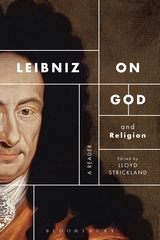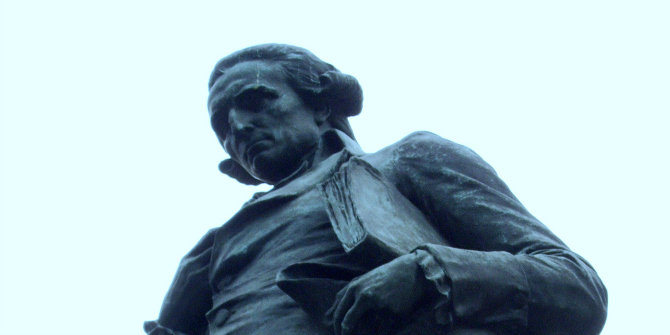In Leibniz: On God and Religion: A Reader, Lloyd Strickland brings together the philosopher’s writing on God and religion, drawing on journal articles, book reviews, private notes, essays and personal correspondence. Praising this volume for its eclectic and illuminating selection of texts, Audrey Borowski argues that, amidst schism, pessimism and uncertainty, the rediscovery of Leibniz’s thought could not be timelier.
Leibniz: On God and Religion: A Reader. Lloyd Strickland (ed.). Bloomsbury. 2016.
Find this book (affiliate link): ![]()
 Gottfried Wilhelm Leibniz (1646-1716) was a German thinker and polymath whose intellect spanned an incredibly broad array of disciplines from mathematics and computation to philosophy and etymological studies. In spite of this, the sheer audacity and ingenuity of his thought – Gottlob Frege once commented that he truly ‘existed in a class of his own’ – have too often been obscured, dismissed or, worse yet, derided.
Gottfried Wilhelm Leibniz (1646-1716) was a German thinker and polymath whose intellect spanned an incredibly broad array of disciplines from mathematics and computation to philosophy and etymological studies. In spite of this, the sheer audacity and ingenuity of his thought – Gottlob Frege once commented that he truly ‘existed in a class of his own’ – have too often been obscured, dismissed or, worse yet, derided.
Lloyd Strickland, a senior lecturer at Manchester Metropolitan University, is a Leibniz specialist who runs a useful website containing many of his translations of Leibniz’s writings. In 2011, he published the philosophical correspondence between Leibniz and his patron, Electress Sophie of Hanover (1630-1714), and the latter’s daughter, Queen Sophie Charlotte of Prussia (1668-1705), which serves as a very fine introduction to Leibniz’s thought for the uninitiated or more sceptical. As we celebrate the tercentenary of Leibniz’s death, Strickland has compiled his writings on philosophical theology, for the very first time bringing together articles, book reviews, private notes and essays as well as items from Leibniz’s extensive correspondence that were hitherto unpublished or unavailable in English. These bring to the fore some recurring themes, including the existence and nature of God, miracles and mysteries, the issue of Grace and predestination, sin, evil and theodicy as well as the afterlife.
While they chart the various changes in Leibniz’s thinking over the course of his career, these texts also bring to the fore the potent didactic streak that pervades the Leibnizian corpus as a whole: far from seeking to conceal or obfuscate, Leibniz sought first and foremost to elucidate and clarify the points he wished to set across. Crucially, too, in an age of growing secularisation, Leibniz undertook a defence of Christianity by formulating a particular type of ‘rational theology’. Whilst he believed in the overall correctness of their reforms, Leibniz regretted that his contemporaries had carried them too far by removing all final causes. Cartesianism on its side had impressed ‘an incurable error’ on the minds of many in its appeal to ‘clear and distinct’ ideas (107).
For Leibniz, God had not crafted an arbitrary universe but one that was ‘free and full of purpose’ (106): ‘Everything has a reason which determines why it is thus rather than otherwise’ (‘An Outline of a Natural Theology’, 91). In this manner, the universe unfolded rationally according to a predetermined and harmonious design, which yielded the most diversity combined with the greatest simplicity of laws. Its study could not fail to arouse pleasure in the perfections of God and inspire us to ‘strive to conform to this order and to what is best’ (‘Critical Remarks on William Penn and the Quakers’). God stood as ‘the ultimate reason of things’ and presided over ‘the most perfect commonwealth […] [the] City of Minds’. In it, no good action went unrewarded, no sin unpunished. Each human being had been endowed with an ‘inner light’, a ‘footprint, indeed an image of the omniscience and omnipotence of God’, which expressed the universe from its own perspective (‘On the True Mystical Theology’). It contained innate knowledge including necessary truths that were independent of sense perception but which could nevertheless be drawn out from the innermost parts of our mind through reasoning (‘On God and Man’). And while God had permitted evil, he did so ‘for a greater good’, although it lay ‘beyond the forces of human reason to show a priori and in detail in what this good consists’ (112). God and his creatures were bound by the same metaphysical and logical principles and coexisted with him in a particular ‘fellowship’. Ultimately, therefore, ‘human reason, when properly grasped, never conflicts with the revealed divine faith’, even though the latter eluded it (as Leibniz opined against John Toland’s 1696 Christianity not mysterious).
At the heart of much of his endeavour lay Leibniz’s lifelong preoccupation with the welfare and advancement of mankind; for him, to contribute to the latter and to the glory of God were ‘the same thing’. His inexorable faith in mankind and its progress was wedded to a deeply pragmatic bent whereby theoretical insights should always find practical applications. In this manner, far from dismissing imagination as inferior, for instance, Leibniz held that it could be harnessed for the greater good by steering passions toward piety. In ‘On the Imagination of the Future Life’, Leibniz elaborated on the subject:
It is well known that martyrs have endured the most excruciating tortures for no other reason than that they had a vivid imagination of future pleasure, for it is impossible for us to resist pain or pleasure except by means of their opposites. […] This imagination in the best state should, by every apparatus of art, be continuously impressed upon men from infancy, and without distinction, upon the wise no less than upon the common man.
As Leibniz summed up, ‘arguments alone are not sufficient to make them go back into themselves; something is needed which stirs passions and ravishes souls’, ‘leading souls away from the vanity of the world’ (149).
Crucially, in this selection of texts, Leibniz reveals his peculiar agility at juggling and dissolving opposing concepts – sin and good deed, change and immutability – as well as his unique skill for redefinition, one which he had no doubt honed during his early legal training. In this way, ‘all the passions can be attributed to God (except those which influence in themselves something bad, like the envy that the ancients so foolishly attributed to their gods), if one takes them for rational inclinations separated from the confusion of the senses.’ He deployed this particular strategy in his defence of the Trinity: far from entailing an ‘untenable contradiction’, it could be construed as one single absolute individual that contained three relative divine persons (‘On the Threefold God’).
Rather than discard ancient sources, Leibniz adopted a conciliatory approach, co-opting various sources, modern and ancient, to suit his own agenda. The Greeks, for instance, had ‘expressed more distinctly’ certain metaphysical principles, such as incorporeal substances and the doctrine of immortality. God, after using ‘the Hebrew race’ ‘as an instrument of his supreme providence’, had ‘later kindled a new light in the human race’: ‘He did this by infusing the Greek mind with the pursuit of wisdom, so that divine truths might be fortified with certain demonstrations against all the doubts of men, who must go onwards to progress over generations towards a greater subtlety of thinking’ (‘On the Greeks as the Founders of a Sacred Philosophy’, 120).
More broadly, Leibniz worked tirelessly towards the reconciliation of the Churches, especially in the wake of the Thirty Years War (1618-48). During his time at the court of the Elector, he even composed a series of works in philosophical theology, the ‘Catholic Demonstrations’, in an attempt to reconcile Protestant and Catholic religious doctrines. For Leibniz, ‘the schism is among the greatest evils of the world and the Church’ (238), especially since ‘one can be saved through the sincere love of God above all things, whatever communion one belongs to’ (‘The True Theology’). This conciliatory impulse culminated in Leibniz’s attempt to flesh out his own system of universal ethics, which revolved around his concept of Justice as famously defined in terms of ‘charity in conformity with wisdom’. Love, too, was ‘nothing other than the state in which one finds one’s pleasure in the perfections of the object love’ (‘The Essence of Piety’).
Strickland’s volume thus presents us with a thoroughly eclectic selection of texts ranging from the curious – Leibniz’s attempt at proving that the valley of Jehoshaphat is sufficiently large to accommodate all the resurrected – to the downright iconoclastic – he considers the case of the resurrection of a man raised solely on human flesh from infancy. Amidst increasing schism, pessimism and uncertainty, the rediscovery of his thought could not be timelier.
Note: This review gives the views of the author, and not the position of the LSE Review of Books blog, or of the London School of Economics. The LSE RB blog may receive a small commission if you choose to make a purchase through the above Amazon affiliate link. This is entirely independent of the coverage of the book on LSE Review of Books.
Image Credit: The statue of Gottfried Wilhelm Leibniz by Ernst Hähnel (1883) in Leipzig, Germany (Ad Meskens, Wikimedia Commons, CC BY SA 3.0).








